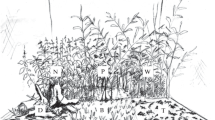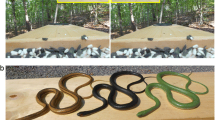Summary
The commonly studied “standard” anti-predatory environment presents animals with spatially-distinct feeding sites and refuges from attack, neither of which necessarily obstructs predator detection. In contrast, tree-trunks provide animals with a markedly “non-standard” environment in which the foraging substrate itself may be a refuge from attack that unavoidably obstructs predator detection. Thus anti-predatory behavior in this environment should be influenced not only by a perceived risk of attack, but also by the nature of the refuge/foraging substrate itself. Downy woodpeckers (Picoides pubescens) are a common tree-trunk foraging animal, and an experimental analysis of their behavior suggests that they respond appropriately to their non-standard anti-predatory environment. In particular, anti-predatory vigilance varies strongly with changes in tree trunk diameter. Two modes of vigilance were apparent. In “stationary” vigilance, woodpeckers maintained the position of their feet while rotating their bodies side-to-side to peer around the trunk; “mobile” vigilance involved movement around the trunk itself. Both the frequency and angle of rotation of stationary vigilance increased with trunk diameter, as did the frequency of mobile vigilance. The woodpeckers also held their heads farther away from the trunk surface as diameter increased. All of these measures of vigilance increased under a greater perceived risk of predation. As might be expected given these results, downy woodpeckers avoided thick trunks; they did not, however, prefer the thinnest (least obstructive) available trunks. These preferences may reflect the influence of trunk diameter on thermo-ecological and/or anti-predator considerations not related to vigilance. Overall, this arboreal environment provides an unusual perspective on anti-predator decision-making with several implications for tree-trunk foraging animals in general.
Similar content being viewed by others
References
Bakken GS (1990) Estimating the effect of wind on avian metabolic rate with standard operative temperature. Auk 107:587–597
Barnard CJ (1980) Flock feeding and time budgets in the house sparrow (Passer domesticus L.). Anim Behav 28:295–309
Bowers MA (1988) Seed removal experiments on desert rodents: the microhabitat by moonlight effect. J Mammal 69:201–204
Brown JS, Kotler BP, Smith RJ, Wirtz EO (1988) The effects of owl predation on the foraging behavior of heteromyid rodents. Oecologia 76:408–415
Caraco T, Martindale S, Pulliam HR (1980) Avian time budgets and distance to cover. Auk 97:872–875
Dill LM, Houtman R (1989) The influence of distance to refuge on flight initiation distance in the gray squirrel (Sciurus carolinensis). Can J Zool 67:232–235
Ekman J (1987) Exposure and time use in willow tit flocks: the cost of subordination. Anim Behav 35:445–452
Elgar MA (1989) Predator vigilance and group size in mammals and birds: a critical review of the empirical evidence. Biol Rev 64:13–33
Elgar MA, Burren PJ, Posen M (1984) Vigilance and perception of flock size in foraging house sparrows (Passer domesticus L.). Behaviour 90:215–223
Grubb TC Jr (1977) Weather-dependent foraging behavior of some birds wintering in a deciduous woodland: horizontal adjustments. Condor 79:271–274
Grubb TC Jr, Greenwald L (1982) Sparrows and a brushpile: foraging responses to different combinations of predation risk and energy cost. Anim Behav 30:637–640
Helfman GS (1989) Predation-risk-sensitive predator avoidance in damselfish-trumpetfish interactions. Behav Ecol Sociobiol 24:47–58
Hogstad O (1988) Social rank and antipredator behavior of willow tits Parus montanus in winter flocks. Ibis 130:45–56
Holmes WG (1984) Predation risk and foraging behavior of the hoary marmot in Alaska. Behav Ecol Sociobiol 15:293–301
Kilham L (1983) Life history studies of woodpeckers of eastern North America. Nuttall Ornithological Club, Cambridge, Massachusetts
Knight SK, Knight RL (1986) Vigilance patterns in bald eagles feeding in groups. Auk 103:263–272
Kotler BP, Brown JS (1988) Environmental heterogeneity and the coexistence of desert rodents. Annu Rev Ecol Syst 19:281–307
Lima SL (1987) Vigilance while feeding and its relation to the risk of predation. J Theor Biol 124:303–316
Lima SL (1990a) Protective cover and the use of space: different strategies in finches. Oikos 58:151–158
Lima SL (1990b) The influence of models on the interpretation of vigilance. In: Bekoff M, Jamieson D (eds) Interpretation and explanation in the study of animal behavior: vol. 2. Explanation, evolution and adaptation. Westview, Boulder, Colorado
Lima SL, Dill LM (1990) Behavioral decisions made under the risk of predation: a review and prospectus. Can J Zool 68:619–640
Metcalfe NB (1984) The effects of habitat on the vigilance of shorebirds: is visibility important? Anim Behav 32:981–985
Moermond TC (1986) A mechanistic approach to the study of communities: Anolis lizards and birds. Am Zool 26:23–37
Newman JA, Caraco T (1987) Foraging, predation hazard and patch use in grey squirrels. Anim Behav 35:1804–1813
Newman JA, Recer GM, Zwicker SM, Caraco T (1988) Effects of predation hazard on foraging “constraints”: patch use strategies in grey squirrels. Oikos 53:93–97
Norberg RA (1981) Why foraging birds in trees should climb and hop upwards rather than downwards. Ibis 123:281–288
Peters WD, Grubb TC Jr (1983) An experimental analysis of sex-specific foraging in the downy woodpecker, Picoides pubescens. Ecology 64:1437–1443
Piper WH (1990) Exposure to predators and access to food in wintering white-throated sparrows Zonotrichia albicollis. Behaviour 112:284–298
Schneider KJ (1984) Dominance, predation, and optimal foraging in white-throated sparrow flocks. Ecology 65:1820–1827
Scott NJ Jr, Wilson DE, Jones C, Andrews RM (1976) The choice of perch dimensions by lizards of the genus Anolis (Reptilia, Lacertilia, Iguanidae). J Herpetol 10:75–84
Sih A (1987) Predators and prey lifestyles: an evolutionary and ecological overview. In: Kerfoot WC, Sih A (eds) Predation: Direct and Indirect Impacts on Aquatic Communities. University Press of New England, Hanover New Hampshire, pp 203–224
Sullivan KA (1984a) Information exploitation by downy woodpeckers in mixed-species flocks. Behaviour 91:294–311
Sullivan KA (1984b) The advantages of social foraging in downy woodpeckers. Anim Behav 32:16–22
Todd IA, Cowie RJ (1990) Measuring the risk of predation in an energy currency: field experiments with foraging blue tits, Parus caeruleus. Anim Behav 40:112–117
Waite TA (1987) Dominance-specific vigilance in the tufted titmouse: effects of social context. Condor 89:932–935
Wilkinson L (1988) SYSTAT: The system for statistics. SYSTAT Inc, Evanston, Illinois
Ydenberg RC, Dill LM (1986) The economics of fleeing from predators. Adv Study Behav 16:229–249
Author information
Authors and Affiliations
Rights and permissions
About this article
Cite this article
Lima, S.L. Vigilance and foraging substrate: anti-predatory considerations in a non-standard environment. Behav Ecol Sociobiol 30, 283–289 (1992). https://doi.org/10.1007/BF00166714
Received:
Accepted:
Issue Date:
DOI: https://doi.org/10.1007/BF00166714




